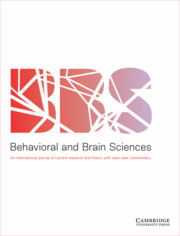Crossref Citations
This article has been cited by the following publications. This list is generated based on data provided by Crossref.
Tsuchiya, Naotsugu
and
Koch, Christof
2009.
The Neurology of Consciousness.
p.
63.
Kouider, Sid
de Gardelle, Vincent
Sackur, Jérôme
and
Dupoux, Emmanuel
2010.
How rich is consciousness? The partial awareness hypothesis.
Trends in Cognitive Sciences,
Vol. 14,
Issue. 7,
p.
301.
Cohen, Michael A.
and
Dennett, Daniel C.
2011.
Consciousness cannot be separated from function.
Trends in Cognitive Sciences,
Vol. 15,
Issue. 8,
p.
358.
Schlicht, Tobias
2012.
Phenomenal consciousness, attention and accessibility.
Phenomenology and the Cognitive Sciences,
Vol. 11,
Issue. 3,
p.
309.
Berkovich-Ohana, Aviva
and
Glicksohn, Joseph
2014.
The consciousness state space (CSS)—a unifying model for consciousness and self.
Frontiers in Psychology,
Vol. 5,
Issue. ,
Weber, Tamar
and
Lau, Hakwan
2015.
International Encyclopedia of the Social & Behavioral Sciences.
p.
673.
Tsuchiya, Naotsugu
and
Koch, Christof
2016.
The Neurology of Conciousness.
p.
71.
Sebastián, Miguel Ángel
2017.
On a Confusion About Which Intuitions to Trust: From the Hard Problem to a Not Easy One.
Topoi,
Vol. 36,
Issue. 1,
p.
31.
Fallon, Francis
2017.
Advanced Research on Biologically Inspired Cognitive Architectures.
p.
1.
LeDoux, Joseph E.
2022.
As soon as there was life, there was danger: the deep history of survival behaviours and the shallower history of consciousness.
Philosophical Transactions of the Royal Society B: Biological Sciences,
Vol. 377,
Issue. 1844,
Usher, Marius
Negro, Niccolò
Jacobson, Hilla
and
Tsuchiya, Naotsugu
2023.
When philosophical nuance matters: safeguarding consciousness research from restrictive assumptions.
Frontiers in Psychology,
Vol. 14,
Issue. ,
Tsuchiya, Naotsugu
Saigo, Hayato
and
Phillips, Steven
2023.
An adjunction hypothesis between qualia and reports.
Frontiers in Psychology,
Vol. 13,
Issue. ,
Schiller, Daniela
Yu, Alessandra N.C.
Alia-Klein, Nelly
Becker, Susanne
Cromwell, Howard C.
Dolcos, Florin
Eslinger, Paul J.
Frewen, Paul
Kemp, Andrew H.
Pace-Schott, Edward F.
Raber, Jacob
Silton, Rebecca L.
Stefanova, Elka
Williams, Justin H.G.
Abe, Nobuhito
Aghajani, Moji
Albrecht, Franziska
Alexander, Rebecca
Anders, Silke
Aragón, Oriana R.
Arias, Juan A.
Arzy, Shahar
Aue, Tatjana
Baez, Sandra
Balconi, Michela
Ballarini, Tommaso
Bannister, Scott
Banta, Marlissa C.
Barrett, Karen Caplovitz
Belzung, Catherine
Bensafi, Moustafa
Booij, Linda
Bookwala, Jamila
Boulanger-Bertolus, Julie
Boutros, Sydney Weber
Bräscher, Anne-Kathrin
Bruno, Antonio
Busatto, Geraldo
Bylsma, Lauren M.
Caldwell-Harris, Catherine
Chan, Raymond C.K.
Cherbuin, Nicolas
Chiarella, Julian
Cipresso, Pietro
Critchley, Hugo
Croote, Denise E.
Demaree, Heath A.
Denson, Thomas F.
Depue, Brendan
Derntl, Birgit
Dickson, Joanne M.
Dolcos, Sanda
Drach-Zahavy, Anat
Dubljević, Olga
Eerola, Tuomas
Ellingsen, Dan-Mikael
Fairfield, Beth
Ferdenzi, Camille
Friedman, Bruce H.
Fu, Cynthia H.Y.
Gatt, Justine M.
de Gelder, Beatrice
Gendolla, Guido H.E.
Gilam, Gadi
Goldblatt, Hadass
Gooding, Anne Elizabeth Kotynski
Gosseries, Olivia
Hamm, Alfons O.
Hanson, Jamie L.
Hendler, Talma
Herbert, Cornelia
Hofmann, Stefan G.
Ibanez, Agustin
Joffily, Mateus
Jovanovic, Tanja
Kahrilas, Ian J.
Kangas, Maria
Katsumi, Yuta
Kensinger, Elizabeth
Kirby, Lauren A.J.
Koncz, Rebecca
Koster, Ernst H.W.
Kozlowska, Kasia
Krach, Sören
Kret, Mariska E.
Krippl, Martin
Kusi-Mensah, Kwabena
Ladouceur, Cecile D.
Laureys, Steven
Lawrence, Alistair
Li, Chiang-shan R.
Liddell, Belinda J.
Lidhar, Navdeep K.
Lowry, Christopher A.
Magee, Kelsey
Marin, Marie-France
Mariotti, Veronica
Martin, Loren J.
Marusak, Hilary A.
Mayer, Annalina V.
Merner, Amanda R.
Minnier, Jessica
Moll, Jorge
Morrison, Robert G.
Moore, Matthew
Mouly, Anne-Marie
Mueller, Sven C.
Mühlberger, Andreas
Murphy, Nora A.
Muscatello, Maria Rosaria Anna
Musser, Erica D.
Newton, Tamara L.
Noll-Hussong, Michael
Norrholm, Seth Davin
Northoff, Georg
Nusslock, Robin
Okon-Singer, Hadas
Olino, Thomas M.
Ortner, Catherine
Owolabi, Mayowa
Padulo, Caterina
Palermo, Romina
Palumbo, Rocco
Palumbo, Sara
Papadelis, Christos
Pegna, Alan J.
Pellegrini, Silvia
Peltonen, Kirsi
Penninx, Brenda W.J.H.
Pietrini, Pietro
Pinna, Graziano
Lobo, Rosario Pintos
Polnaszek, Kelly L.
Polyakova, Maryna
Rabinak, Christine
Helene Richter, S.
Richter, Thalia
Riva, Giuseppe
Rizzo, Amelia
Robinson, Jennifer L.
Rosa, Pedro
Sachdev, Perminder S.
Sato, Wataru
Schroeter, Matthias L.
Schweizer, Susanne
Shiban, Youssef
Siddharthan, Advaith
Siedlecka, Ewa
Smith, Robert C.
Soreq, Hermona
Spangler, Derek P.
Stern, Emily R.
Styliadis, Charis
Sullivan, Gavin B.
Swain, James E.
Urben, Sébastien
Van den Stock, Jan
vander Kooij, Michael A.
van Overveld, Mark
Van Rheenen, Tamsyn E.
VanElzakker, Michael B.
Ventura-Bort, Carlos
Verona, Edelyn
Volk, Tyler
Wang, Yi
Weingast, Leah T.
Weymar, Mathias
Williams, Claire
Willis, Megan L.
Yamashita, Paula
Zahn, Roland
Zupan, Barbra
and
Lowe, Leroy
2024.
The Human Affectome.
Neuroscience & Biobehavioral Reviews,
Vol. 158,
Issue. ,
p.
105450.
Simmons, Claire
Krasich, Kristina
Chitre, Aditi
and
Sinnott-Armstrong, Walter
2025.
Does conscious perception render agents more responsible? A study of lay judgments.
Journal of Experimental Social Psychology,
Vol. 119,
Issue. ,
p.
104757.

